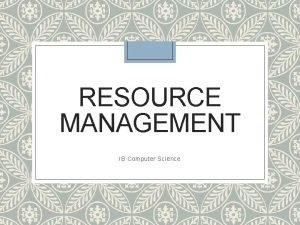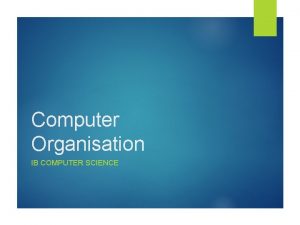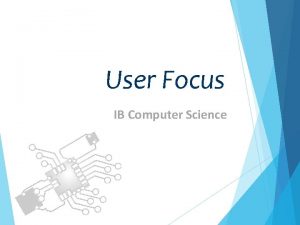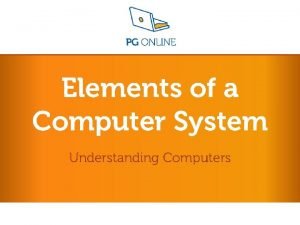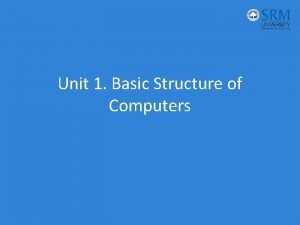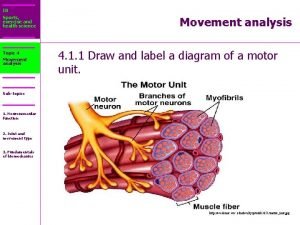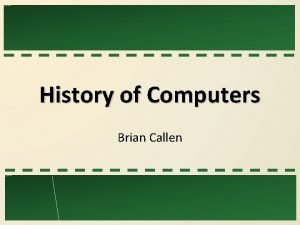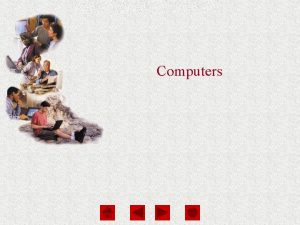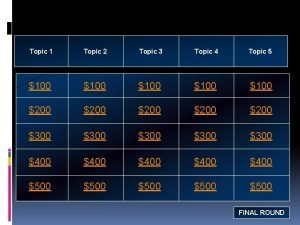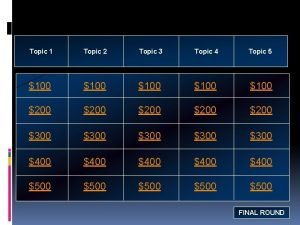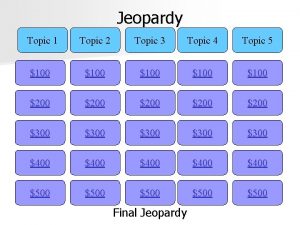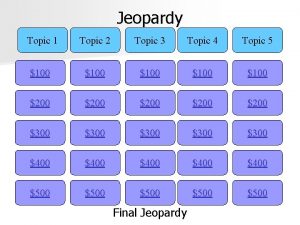Topic 4 Computers Computer Architecture Computer Science The
















- Slides: 16

Topic 4: Computers Computer Architecture Computer Science

The Basic Computer Model • Computers can do different things based on what they were made for Calculators calculate values Tills record and calculate money totals • However, computers have evolved over time Originally just for number crunching Now can do lots of different things • We’re going to look at what a computer is, what a computer can do, and what a computer contains 2 Computers: Compter Architecture

The Basic Computer Model • Before going in-depth with these, we need to know one thing Different ‘computers’ can do different things • There’s a simple way to break this down The Input-Process-Output model Input 3 Process Computers: Compter Architecture Output

The Basic Computer Model • Shows the general flow of data through a computer We give the computer some input The computer performs a process (or series of processes) The computer outputs some data • The Input/Process/Output are different per Input Process Output device 4 Computers: Compter Architecture

The Basic Computer Model Calculator receives operands/operator Calculator performs operations Calculator displays result Printer stores document for printing Printer prints the document The elevator moves to the correct floor The elevator door opens in front of user Printer receives a document Elevator button is pressed 5 Computers: Compter Architecture

Other Computer Models • There are other computer models out there Mostly involving programs and how they operate • Some examples include Sequential model: when instructions in a program are executed one after the other Parallel model: when instructions in a program are executed simultaneously across multiple processors Multi-agent model: when multiple computer systems cooperate with each other to achieve a goal 6 Computers: Compter Architecture

Computer Components Central Processing Unit (CPU, a. k. a. Processor) • Considered to be the brain of the computer • Is a single, small chip (that can be quite fragile) • Responsible for executing programs, performing basic operations, and supervising other components 7 Computers: Compter Architecture

Computer Components Main Memory (RAM, ROM, EEPROM) • Stores temporary/permanent data Values for a program Machine code that will be executed on the CPU • Accessed via addresses (binary numbers determined by CPU architecture) • Comes in different types, chip sizes (both memory and physical size), and different speeds 8 Computers: Compter Architecture

Computer Components Main Memory (RAM, ROM, EEPROM) • RAM – Random Access Memory • Writable and readable stores for data But volatile • RAM addresses are temporary, and only store data while the computer is powered on 9 Computers: Compter Architecture

Computer Components Main Memory (RAM, ROM, EEPROM) • RAM can be found in a few places ‘Sticks’ of RAM for general data storage CPU can have a cache as well • Caches are fast-access RAM stores used mostly by the CPU • Allows the CPU to store frequently references data (like program instructions) 10 Can speed up process time over storing this data in usual RAM Computers: Compter Architecture

Computer Components Main Memory (RAM, ROM, EEPROM) • RAM is great, but sometimes we may not have enough • The computer can compensate for this with virtual memory Uses sections of slower memory (like EEPROM or Hard Disks) as a replacement for RAM • Is slower (as RAM isn’t entirely used), but used as a ‘last resort’ 11 Computers: Compter Architecture

Computer Components Main Memory (RAM, ROM, EEPROM) • ROM – Read Only Memory • Readable only Contains pre-made data/programs • Often used to store a program that boots the operating system on the computer 12 Computers: Compter Architecture

Computer Components Main Memory (RAM, ROM, EEPROM) • EEPROM – Electrically Erasable Programmable Read Only Memory • Writable and readable, and non-volatile Data is permanently stored until overwritten or destroyed • Comes in lots of different formats 13 Examples include USB sticks, Computers: Compter Architecture SD cards, and Solid-

Computer Components Secondary Storage (Hard-Disk Drives and Solid-State Drives) • Used to store permanent data on the computer The operating system Installed programs Day-to-day files • Slower at being accessed than Main Memory • Examples include Hard-Disk Drives Solid-State Drives 14 Computers: Compter Architecture

Computer Components Input/Output Devices • Help the user use a computer • Input devices let the user interact with the computer Mouse and Keyboard Microphone • Output devices let the computer show results/data to the user Monitor Speakers 15 Computers: Compter Architecture

 Ib computer science topic 6
Ib computer science topic 6 Ib computer science topic 1 questions
Ib computer science topic 1 questions Ib computer science topic 1
Ib computer science topic 1 What is a witches favourite subject in school
What is a witches favourite subject in school Clincher sentence
Clincher sentence Research problem example for students
Research problem example for students Buses in computer architecture
Buses in computer architecture Elements of a computer
Elements of a computer Basic structure of computer
Basic structure of computer Difference computer organization and architecture
Difference computer organization and architecture Design of basic computer
Design of basic computer Ib sehs topic 4
Ib sehs topic 4 Hát kết hợp bộ gõ cơ thể
Hát kết hợp bộ gõ cơ thể Slidetodoc
Slidetodoc Bổ thể
Bổ thể Tỉ lệ cơ thể trẻ em
Tỉ lệ cơ thể trẻ em Voi kéo gỗ như thế nào
Voi kéo gỗ như thế nào
